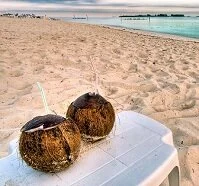Regional Variations, Specialties, & Unique Dishes
Boiled Fish & Grits: as simple as the name sounds, usually served for breakfast
Conch: the national dish of conch served with rice and peas
Dining Etiquette
Dining in the Bahamas is generally a very relaxed event in which etiquette and appearance take a back seat to enjoyment, but if you're dining in someone's home you must be a little more formal. If meeting a local for a meal, whether that's in their home or in public arrive on time and if dining in their home dress in nice clothes, even so much as wearing a tie or a dress.
Your host will show you a seat and your host will also indicate when you may begin eating, at which point the formality sinks quite a bit as dining is meant to be enjoyed and conversation should take over. Many times meals are served family style so try everything possible, but the Bahamians are more forgiving than most if you have an aversion to a particular food. Eat in the continental style (knife in the right hand, fork in the left) and keep your hands in sight by resting your wrists on the table.
As you are done eating, finish all the food on your plate and thank your hosts. Dinner may be followed with dessert or coffee, but this is not standard so don't expect it or be surprised if it is offered.
If you dine in a restaurant, check the bill to see if a gratuity has already been added. If it has there is no need to add a tip above that amount, if not a tip of about 15% is considered appropriate based on the service.
Celebrations & Events
To get a good feel of traditional Bahamian foods, the best time to visit is during Junkanoo, which is a celebration in honor of a local chief. Every year this festival takes place from December 26 to January 1 to celebration the time when slaves were allowed to return home to their families. The food served during this time is very traditional food as conch, fish, rice, fruit, and of course rum are essential elements for every meal. Bimini is the best place to experience this festival.
For Christmas most families serve ham or turkey as the main course. There are also numerous side dishes with Christmas, including rice, potatoes, yams, and numerous other side dishes. However Christmas tends to be an intimate family affair and rarely will a foreigner be invited to a family's dinner
Most other holidays in the Bahamas, including personal celebrations, generally serve similar foods as are served during Junkanoo, although many individuals will alter the menu to suit their particular tastes.
Drinks

Coconut drink
Drinks in the Bahamas are varied, but not unique. Any popular drinks that can be found elsewhere can be found in the Bahamas from juices and colas to coffee and tea. Perhaps the most popular drinks are their juices, which come in numerous flavors including pineapple, guava, passion fruit, and more.
As far as alcoholic drinks are concerned, the Bahamas is known for its rum, much as the rest of the Caribbean is. While the Bahamas makes their own rums, including the vanilla-flavored Nassau Royale, they are more known for the specific mixed drinks that use rum. The "Bahama Mama" is rum mixed with grenadine, orange juice, pineapple juice and ice, while the "Bahama Breeze" is rum and other liquors mixed with lemon, orange, and pineapple juices. Other alcoholic drinks are also popular like beer and wine, although neither holds a place in the hearts or stomachs of the people like rum does.
The tap water is generally safe to drink in the Bahamas, however confirm this with your hotel or guesthouse, particularly during hurricane season as the water can be contaminated. If you do drink the water, many people may have trouble adjusting to the local tap water, as it will most certainly be different from what your system is used to if you are not from the region.